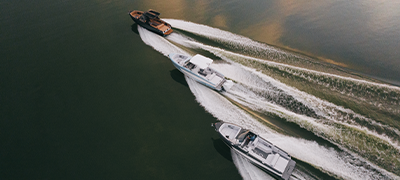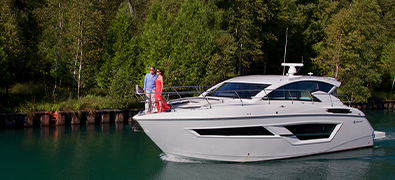Obscure Boat Terms
There are many terms in boating that are not universally understood. Almost everyone knows what the bow is on a boat. Most know that the port is the left side of the boat when facing forward and starboard is the right side when facing forward. So why not use left and right? Terms like port and starboard reduce ambiguities when communicating with people facing different directions.
-

Sponson
What is a sponson one might ask? Officially, it is a feature on any watercraft that extends from the vessel to aid in stability while floating. Picture a seaplane’s pods that extend out from the plane’s underside, these are sponsons. Boston Whaler’s earliest designer, Bob Dougherty, famously brought the forward most portion of the twin sponsons into what the company called the “Whaler Smirk.” Sponsons add stability when underway or at rest. They also make turns sharper as they dig in on the inside of the turn.
-

Fairleads and Chocks
Fairleads and chocks are terms that are regularly misused even by experienced boaters. A fairlead is a device to guide working lines with fixed rollers around other objects onboard. A chock is designed to keep lines from moving laterally when fixed to a cleat. This is what ties your boat to the dock.
-

Hawse Pipe
Many boats incorporate hawse pipes in their design to avoid the hazards that exposed cleats create. In lieu of having a fixed cleat on the gunwale or transom platform, the cleat is mounted out of the way underneath the gunwale with an opening in the gunwale to pass a dock line through, making it easier to anchor up. The pass-through is called the hawse pipe.
-
Sheer
Boats are often defined by their sheer line, which is the transition of the gunwale from the transom to the bow. Most boats have a graceful sheer that rises from the stern of the boat to the bow. Some have what is referred to as a broken sheer which means the transition forward is not smooth, there is a break along the sheer.
-

Deadrise
The deadrise of a boat is the hull’s angle in degrees, as measured from the aft-most portion of the vessel. Deadrise has a lot to do with how a boat will ride. This angle is measured throughout the length of the hull. The manufacturers often refer to the deadrise at the transom to let potential customers understand what to expect from the boat performance. 20-degrees or more of deadrise at the transom usually defines a high-performance hull with a soft ride. The trade-off is an aggressive deadrise makes a deeper hull which will not be capable of shallow water passages.
-

Strakes
Originally strakes were the longitudinal boards that formed the hull. These longitudinal ridges in the hull run from the transom towards the bow, often to the boat stem. Strake design varies from model to model but generally help the boat get on plane quickly and in turn improve the boats straight line tracking.
-

Wheelhouse
The wheelhouse of a boat is literally the sheltered area where the steering wheel is located, either at the inside helm station or the bridge of the boat. Wheelhouse has become an expression meaning within a person’s general knowledge and that person is advantageously at ease. As in “… as the questions become less hypothetical and more about simple math he should be in his wheelhouse.”
-
Winch and Windlass
A winch and a windlass are often confused because they pretty much serve the same purpose, to move heavy object more easily. A winch is a deck apparatus with a vertical cylinder that is either cranked or electrically actuated to raise and lower sails, control the sails sheets, or anchor. Trailers often have a winch to snug up the boat on the trailer. A windlass is a device for raising -

Chine
A boat chine is where the hull bottom transitions into the hull’s side. Rounded chines were typical before the advent of the deep-V hull. As more manufacturers developed sporty models with adaptations of Hunt’s deep-V they discovered that at low speeds and when sitting still, the V-form created an instability when peopled moved about or in a seaway. To create more stability designers lowered the chine to just below the waterline which created a more submerged beam. Today, deep-V hulls have “hard” or “reversed” chines. As the deadrise meets the hull side the chine is either wide and flat or wide and angled downward. This provides stability much like a sponson and provides lift while directing the wash down and away from the boat.
-

Displacement Hull
Displacement hulls are designed to push through the water with less demand for propulsion often making them more efficient. The amount of water pushed aside equals the mass of the boat, thus displacement. As a very general rule the maximum speed of any displacement hull, more commonly called its hull speed, is governed by a simple formula.
-
Yar
Pronounced “yar” the word is most often associated with being in excellent condition for the mission at hand. It is a bit antiquated as a term but someone may, upon seeing a particularly well appointed full displacement yacht with a sensuous sheer and gunwale running along the forward wheelhouse and bow mounted heavy duty windlass, say “my, that boat sure is yar.”

Boat Types

Brush Up Your Boating Skills

